Effects of Wheel Rotation on Long-Period Wake Dynamics of the DrivAer Fastback Model
Abstract
1. Introduction
2. Methodology
2.1. DrivAer Model
2.2. Domain and Flow Conditions
2.3. Mesh
2.4. Lattice Boltzmann Method (LBM)
3. Results and Discussion
3.1. Time-Averaged Flow
3.2. Long-Period Dynamics
4. Conclusions
Author Contributions
Funding
Acknowledgments
Conflicts of Interest
Appendix A
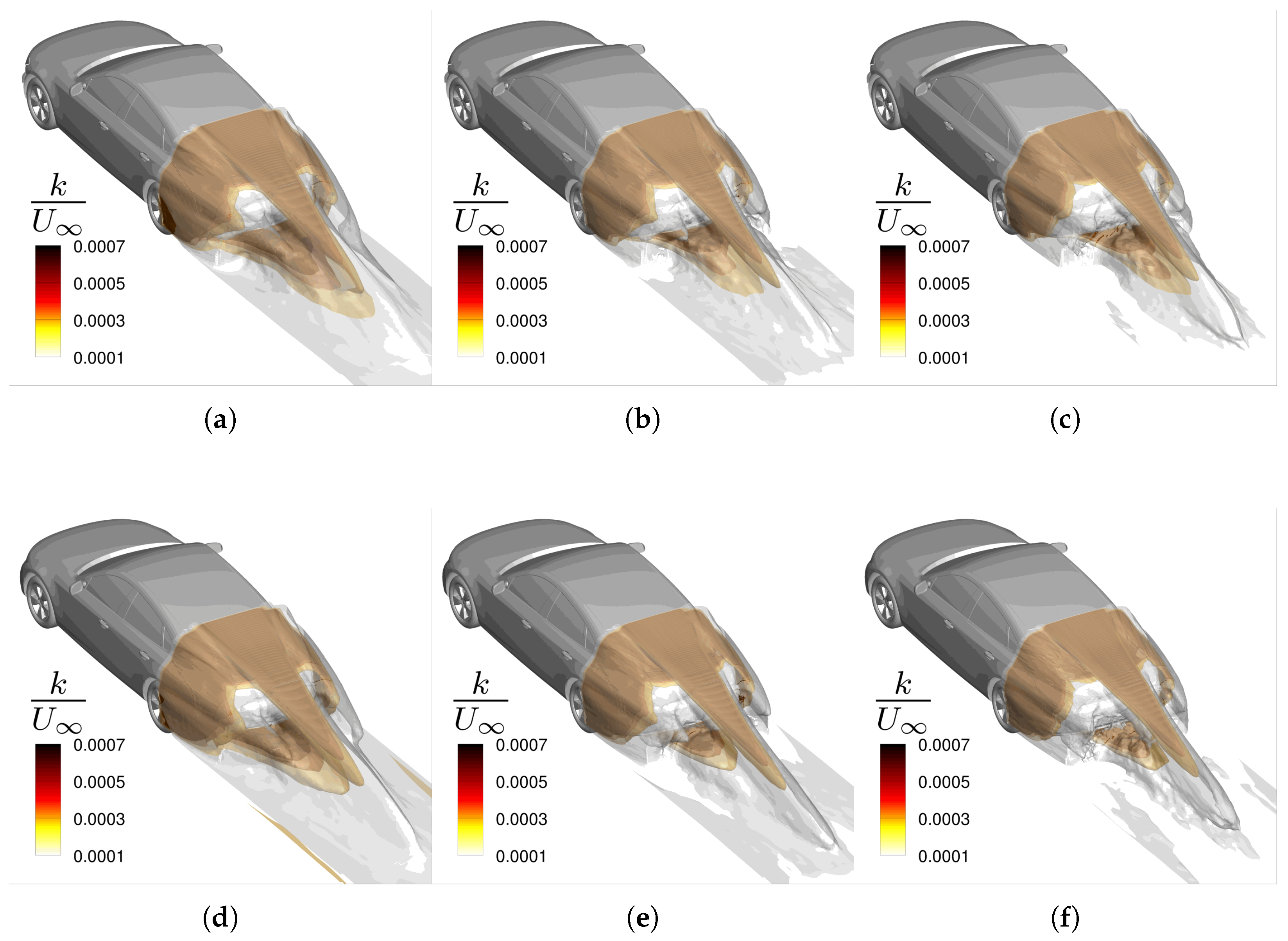
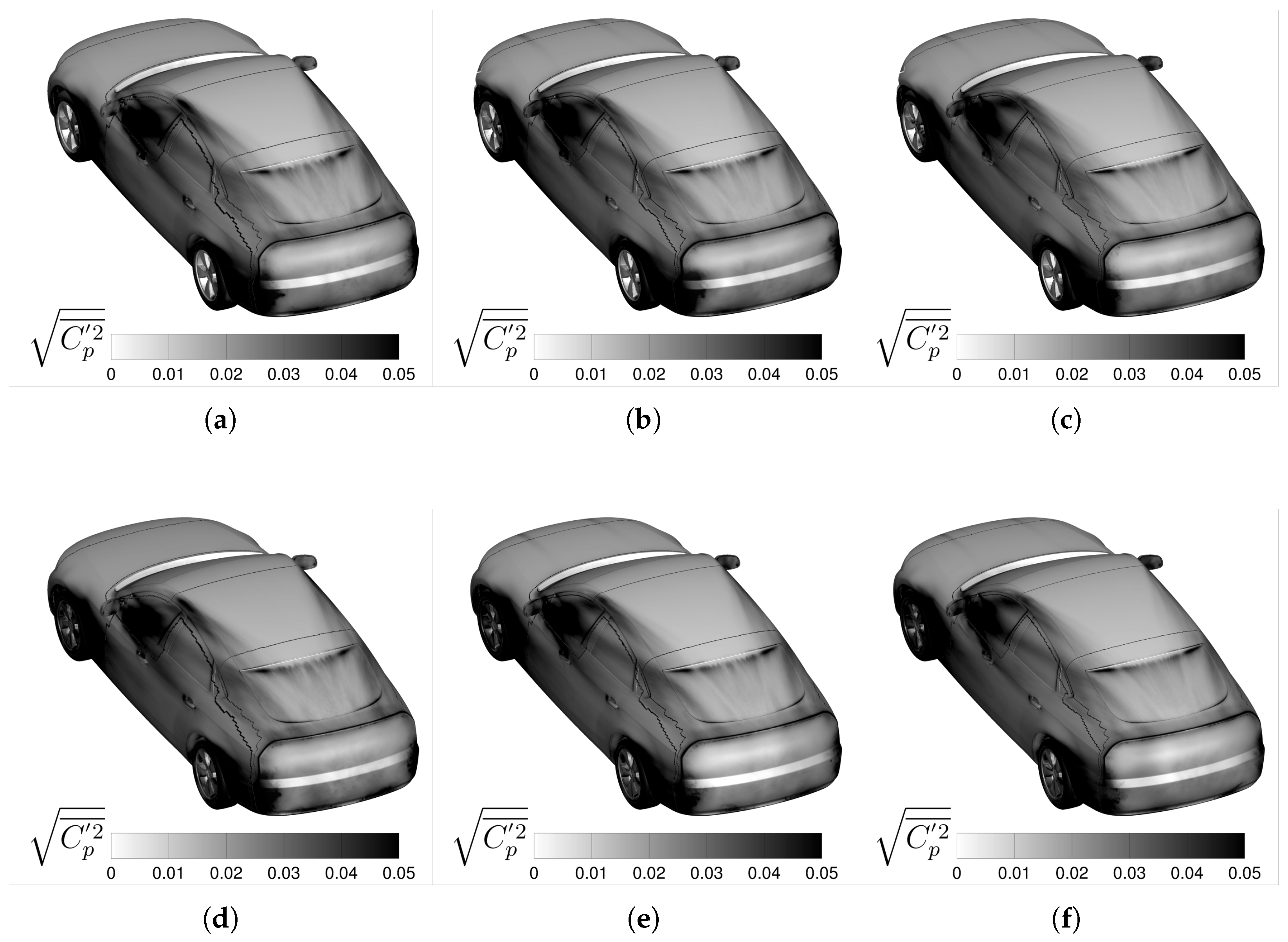


References
- Ahmed, S.R.; Ramm, G.; Faltin, G. Some salient features of the time-averaged ground vehicle wake. SAE Trans. 1984, 93, 473–503. [Google Scholar]
- Pavia, G.; Passmore, M. Characterisation of wake bi-stability for a square-back geometry with rotating wheels. In Proceedings of the FKFS Conference, Stuttgart, Germany, 26–27 September 2017; Springer: Cham, Switzerland, 2017; pp. 93–109. [Google Scholar]
- Grandemange, M.; Gohlke, M.; Cadot, O. Turbulent wake past a three-dimensional blunt body. Part 1. Global modes and bi-stability. J. Fluid Mech. 2013, 722, 51–84. [Google Scholar] [CrossRef]
- Pavia, G.; Passmore, M.; Varney, M.; Hodgson, G. Salient three-dimensional features of the turbulent wake of a simplified square-back vehicle. J. Fluid Mech. 2020, 888, A33. [Google Scholar] [CrossRef]
- Pavia, G.; Passmore, M.; Gaylard, A. Influence of Short Rear End Tapers on the Unsteady Base Pressure of a Simplified Ground Vehicle; Technical Report; SAE Technical Paper; SAE: Warrendale, PA, USA, 2016. [Google Scholar]
- Pavia, G.; Passmore, M.; Sardu, C. Evolution of the bi-stable wake of a square-back automotive shape. Exp. Fluids 2018, 59, 20. [Google Scholar] [CrossRef]
- Pavia, G.; Passmore, M.; Varney, M. Low-frequency wake dynamics for a square-back vehicle with side trailing edge tapers. J. Wind Eng. Ind. Aerodyn. 2019, 184, 417–435. [Google Scholar] [CrossRef]
- Perry, A.K.; Pavia, G.; Passmore, M. Influence of short rear end tapers on the wake of a simplified square-back vehicle: Wake topology and rear drag. Exp. Fluids 2016, 57, 1–17. [Google Scholar] [CrossRef]
- Perry, A.K.; Almond, M.; Passmore, M.; Littlewood, R. The study of a bi-stable wake region of a generic squareback vehicle using tomographic PIV. SAE Int. J. Passeng. Cars-Mech. Syst. 2016, 9, 743–753. [Google Scholar] [CrossRef]
- Grandemange, M.; Cadot, O.; Gohlke, M. Reflectional symmetry breaking of the separated flow over three-dimensional bluff bodies. Phys. Rev. E 2012, 86, 035302. [Google Scholar] [CrossRef]
- Grandemange, M.; Gohlke, M.; Cadot, O. Turbulent wake past a three-dimensional blunt body. Part 2. Experimental sensitivity analysis. J. Fluid Mech. 2014, 752, 439–461. [Google Scholar] [CrossRef]
- Brackston, R.D.; De La Cruz, J.G.; Wynn, A.; Rigas, G.; Morrison, J. Stochastic modelling and feedback control of bistability in a turbulent bluff body wake. J. Fluid Mech. 2016, 802, 726–749. [Google Scholar] [CrossRef]
- Evrard, A.; Cadot, O.; Herbert, V.; Ricot, D.; Vigneron, R.; Délery, J. Fluid force and symmetry breaking modes of a 3D bluff body with a base cavity. J. Fluids Struct. 2016, 61, 99–114. [Google Scholar] [CrossRef]
- He, K.; Minelli, G.; Wang, J.; Dong, T.; Gao, G.; Krajnović, S. Numerical investigation of the wake bi-stability behind a notchback Ahmed body. J. Fluid Mech. 2021, 926, A36. [Google Scholar] [CrossRef]
- He, K.; Minelli, G.; Wang, J.; Gao, G.; Krajnović, S. Assessment of LES, IDDES and RANS approaches for prediction of wakes behind notchback road vehicles. J. Wind Eng. Ind. Aerodyn. 2021, 217, 104737. [Google Scholar] [CrossRef]
- Lucas, J.M.; Cadot, O.; Herbert, V.; Parpais, S.; Délery, J. A numerical investigation of the asymmetric wake mode of a squareback Ahmed body–Effect of a base cavity. J. Fluid Mech. 2017, 831, 675–697. [Google Scholar] [CrossRef]
- Varney, M.; Passmore, M.; Gaylard, A. The effect of passive base ventilation on the aerodynamic drag of a generic SUV vehicle. SAE Int. J. Passeng. Cars-Mech. Syst. 2017, 10, 345–357. [Google Scholar] [CrossRef]
- Haffner, Y.; Borée, J.; Spohn, A.; Castelain, T. Mechanics of bluff body drag reduction during transient near-wake reversals. J. Fluid Mech. 2020, 894. [Google Scholar] [CrossRef]
- Golding, J.F.; Mueller, A.; Gresty, M.A. A motion sickness maximum around the 0.2 Hz frequency range of horizontal translational oscillation. Aviat. Space Environ. Med. 2001, 72, 188–192. [Google Scholar] [PubMed]
- Golding, J.F.; Gresty, M.A. Motion sickness. Curr. Opin. Neurol. 2005, 18, 29–34. [Google Scholar] [CrossRef]
- Donohew, B.E.; Griffin, M.J. Motion sickness: Effect of the frequency of lateral oscillation. Aviat. Space Environ. Med. 2004, 75, 649–656. [Google Scholar] [PubMed]
- Young, S. Vehicle NVH development process and technologies. In Proceedings of the 21st International Congress, Beijing, China, 13–17 July 2014. [Google Scholar]
- Bertolini, G.; Straumann, D. Moving in a moving world: A review on vestibular motion sickness. Front. Neurol. 2016, 7, 14. [Google Scholar] [CrossRef] [PubMed]
- Cheung, B.; Nakashima, A. A Review on the Effects of Frequency of Oscillation on Motion Sickness; Defence R&D: Toronto, ON, Canada, 2006. [Google Scholar]
- Grandemange, M.; Cadot, O.; Courbois, A.; Herbert, V.; Ricot, D.; Ruiz, T.; Vigneron, R. A study of wake effects on the drag of Ahmed’s squareback model at the industrial scale. J. Wind Eng. Ind. Aerodyn. 2015, 145, 282–291. [Google Scholar] [CrossRef]
- Sims-Williams, D.; Marwood, D.; Sprot, A. Links between notchback geometry, aerodynamic drag, flow asymmetry and unsteady wake structure. SAE Int. J. Passeng. Cars-Mech. Systems. 2011, 4, 156–165. [Google Scholar] [CrossRef][Green Version]
- Bonnavion, G.; Cadot, O.; Évrard, A.; Herbert, V.; Parpais, S.; Vigneron, R.; Délery, J. On multistabilities of real car’s wake. J. Wind Eng. Ind. Aerodyn. 2017, 164, 22–33. [Google Scholar] [CrossRef]
- Bonnavion, G.; Cadot, O.; Herbert, V.; Parpais, S.; Vigneron, R.; Délery, J. Asymmetry and global instability of real minivans’ wake. J. Wind Eng. Ind. Aerodyn. 2019, 184, 77–89. [Google Scholar] [CrossRef]
- Heft, A.I.; Indinger, T.; Adams, N.A. Experimental and numerical investigation of the DrivAer model. In Fluids Engineering Division Summer Meeting; American Society of Mechanical Engineers: New York, NY, USA, 2012; Volume 44755, pp. 41–51. [Google Scholar]
- Forbes, D.; Page, G.; Passmore, M.; Gaylard, A. A study of computational methods for wake structure and base pressure prediction of a generic SUV model with fixed and rotating wheels. Proc. Inst. Mech. Eng. Part D J. Automob. Eng. 2017, 231, 1222–1238. [Google Scholar] [CrossRef]
- Heft, A.I.; Indinger, T.; Adams, N.A. Introduction of a New Realistic Generic Car Model for Aerodynamic Investigations; Technical Report; SAE Technical Paper; SAE: Warrendale, PA, USA, 2012. [Google Scholar]
- Collin, C.; Mack, S.; Indinger, T.; Mueller, J. A numerical and experimental evaluation of open jet wind tunnel interferences using the DrivAer reference model. SAE Int. J. Passeng. Cars-Mech. Syst. 2016, 9, 657–679. [Google Scholar] [CrossRef]
- 1st Automotive CFD Prediction Workshop. 2019. Available online: https://autocfd.eng.ox.ac.uk/ (accessed on 13 December 2019).
- Ljungskog, E.; Sebben, S.; Broniewicz, A. Inclusion of the physical wind tunnel in vehicle CFD simulations for improved prediction quality. J. Wind Eng. Ind. Aerodyn. 2020, 197, 104055. [Google Scholar] [CrossRef]
- Diasinos, S.; Barber, T.J.; Doig, G. The effects of simplifications on isolated wheel aerodynamics. J. Wind Eng. Ind. Aerodyn. 2015, 146, 90–101. [Google Scholar] [CrossRef]
- Fares, E. Unsteady flow simulation of the Ahmed reference body using a lattice Boltzmann approach. Comput. Fluids 2006, 35, 940–950. [Google Scholar] [CrossRef]
- Islam, A.; Gaylard, A.; Thornber, B. A detailed statistical study of unsteady wake dynamics from automotive bluff bodies. J. Wind Eng. Ind. Aerodyn. 2017, 171, 161–177. [Google Scholar] [CrossRef]
- Aultman, M.T.; Auza-Gutierrez, R.; Wang, Z.; Duan, L. Characterization of the Flow past the Fastback DrivAer Automotive Model Using Unsteady Simulations. In Proceedings of the AIAA Scitech 2021 Forum, Virtual Event, 11–15 & 19–21 January 2021; p. 1329. [Google Scholar]
- Kotapati, R.; Keating, A.; Kandasamy, S.; Duncan, B.; Shock, R.; Chen, H. The Lattice-Boltzmann-VLES Method for Automotive Fluid Dynamics Simulation, a Review; Technical Report; SAE Technical Paper; SAE: Warrendale, PA, USA, 2009. [Google Scholar]
- Guilmineau, E. Numerical simulations of ground simulation for a realistic generic car model. In Fluids Engineering Division Summer Meeting; American Society of Mechanical Engineers: New York, NY, USA, 2014; Volume 46230, p. V01CT17A001. [Google Scholar]
- Peters, B.C.; Uddin, M.; Bain, J.; Curley, A.; Henry, M. Simulating DrivAer with Structured Finite Difference Overset Grids; Technical Report; SAE Technical Paper; SAE: Warrendale, PA, USA, 2015. [Google Scholar]
- Schewe, G. Experimental observation of the “golden section” in flow round a circular cylinder. Phys. Lett. A 1985, 109, 47–50. [Google Scholar] [CrossRef]
- Strangfeld, C.; Wieser, D.; Schmidt, H.J.; Woszidlo, R.; Nayeri, C.; Paschereit, C. Experimental Study of Baseline Flow Characteristics for the Realistic Car Model Drivaer; Technical Report; SAE Technical Paper; SAE: Warrendale, PA, USA, 2013. [Google Scholar]
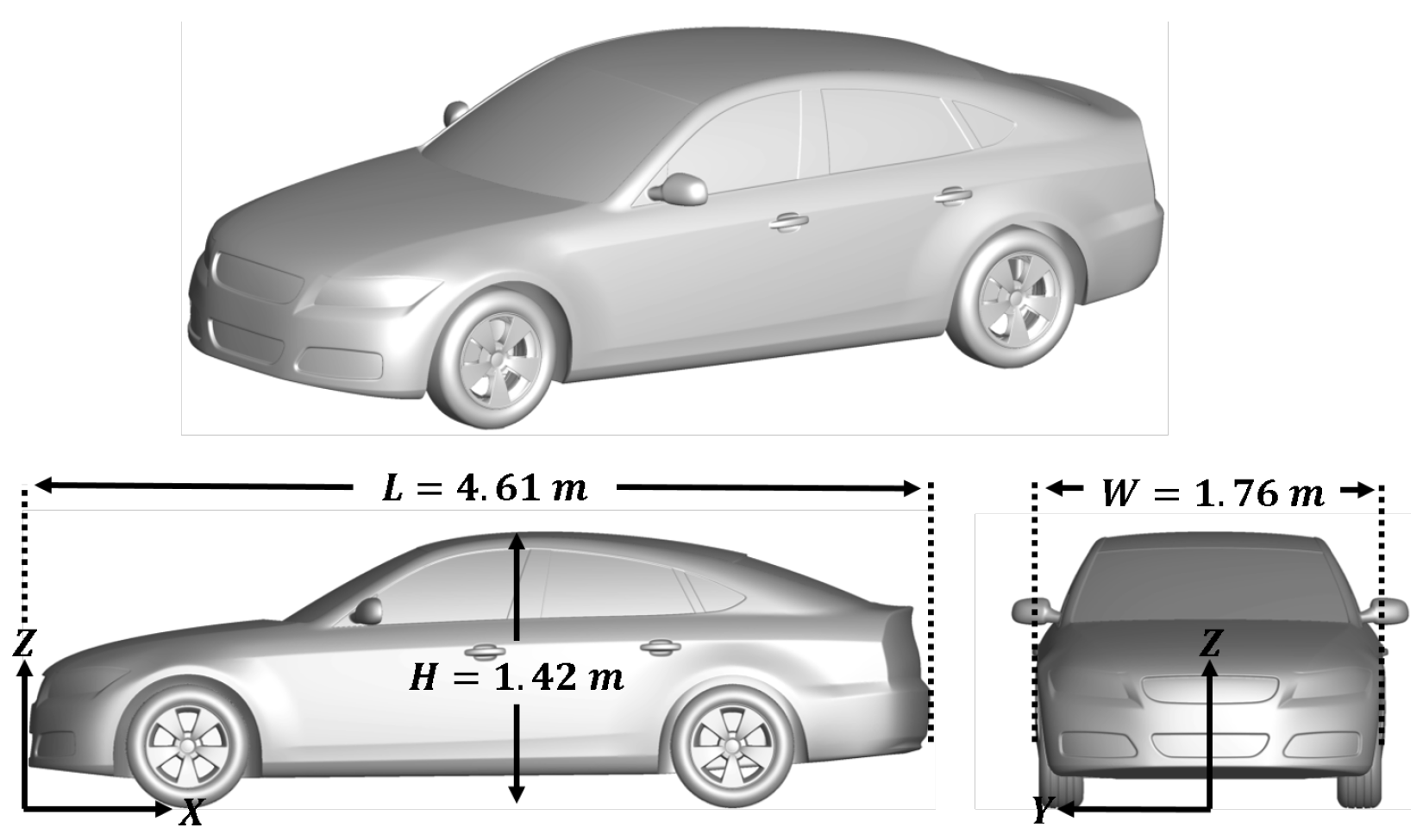

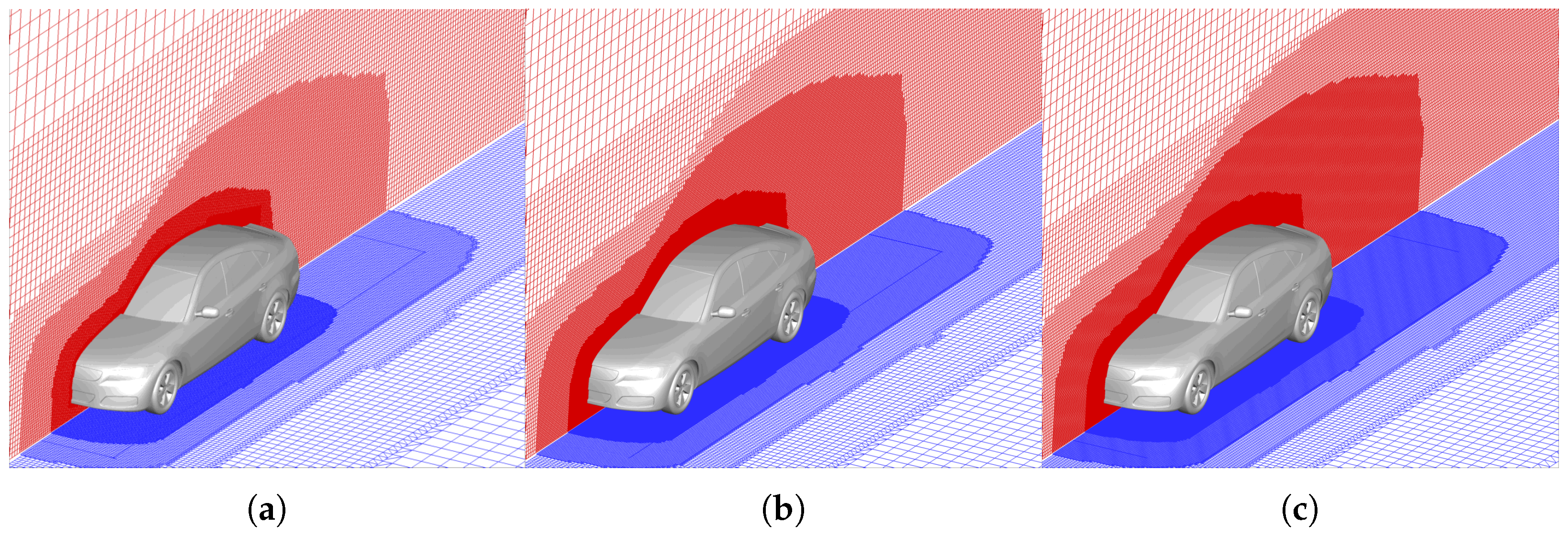
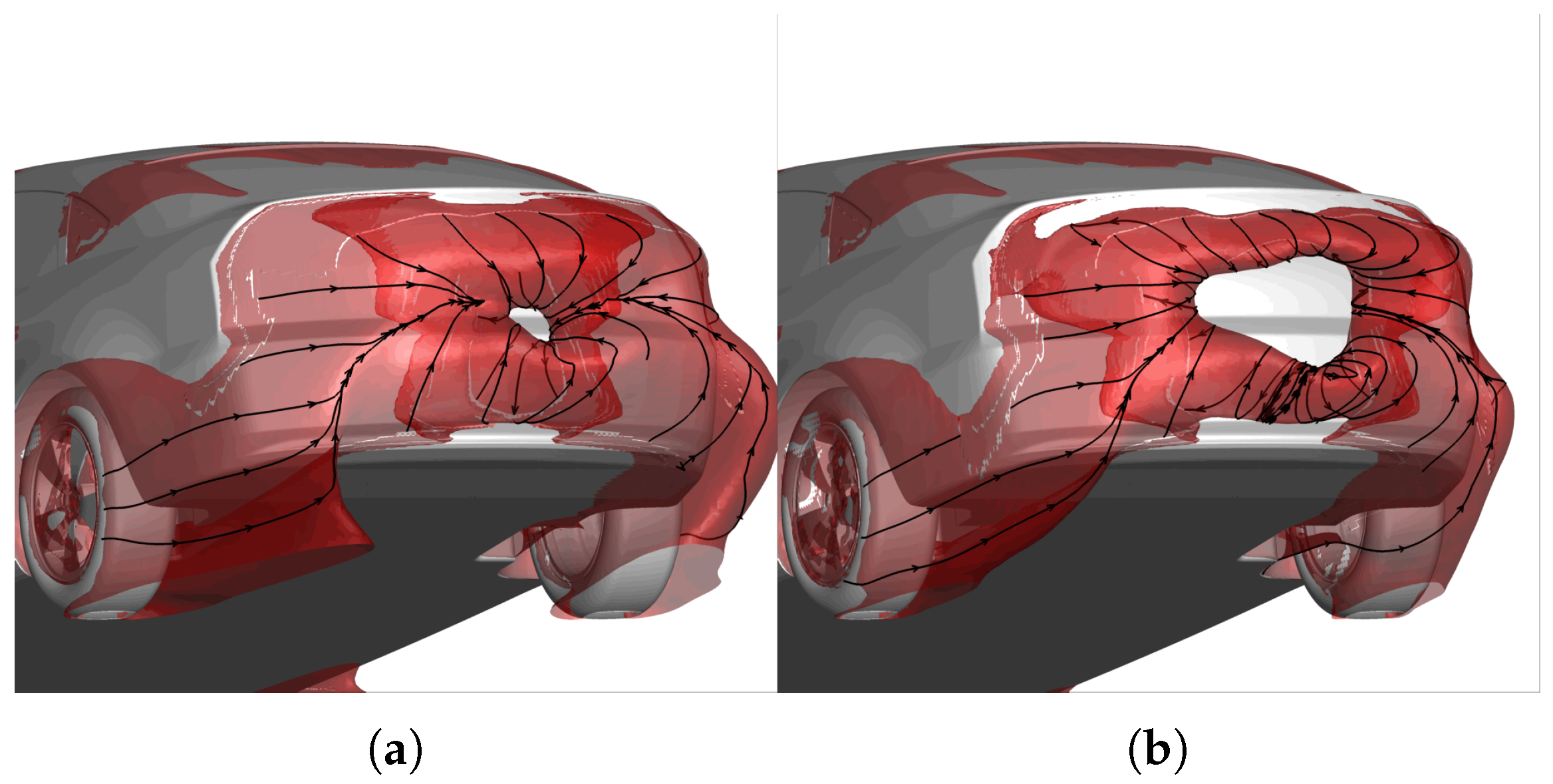
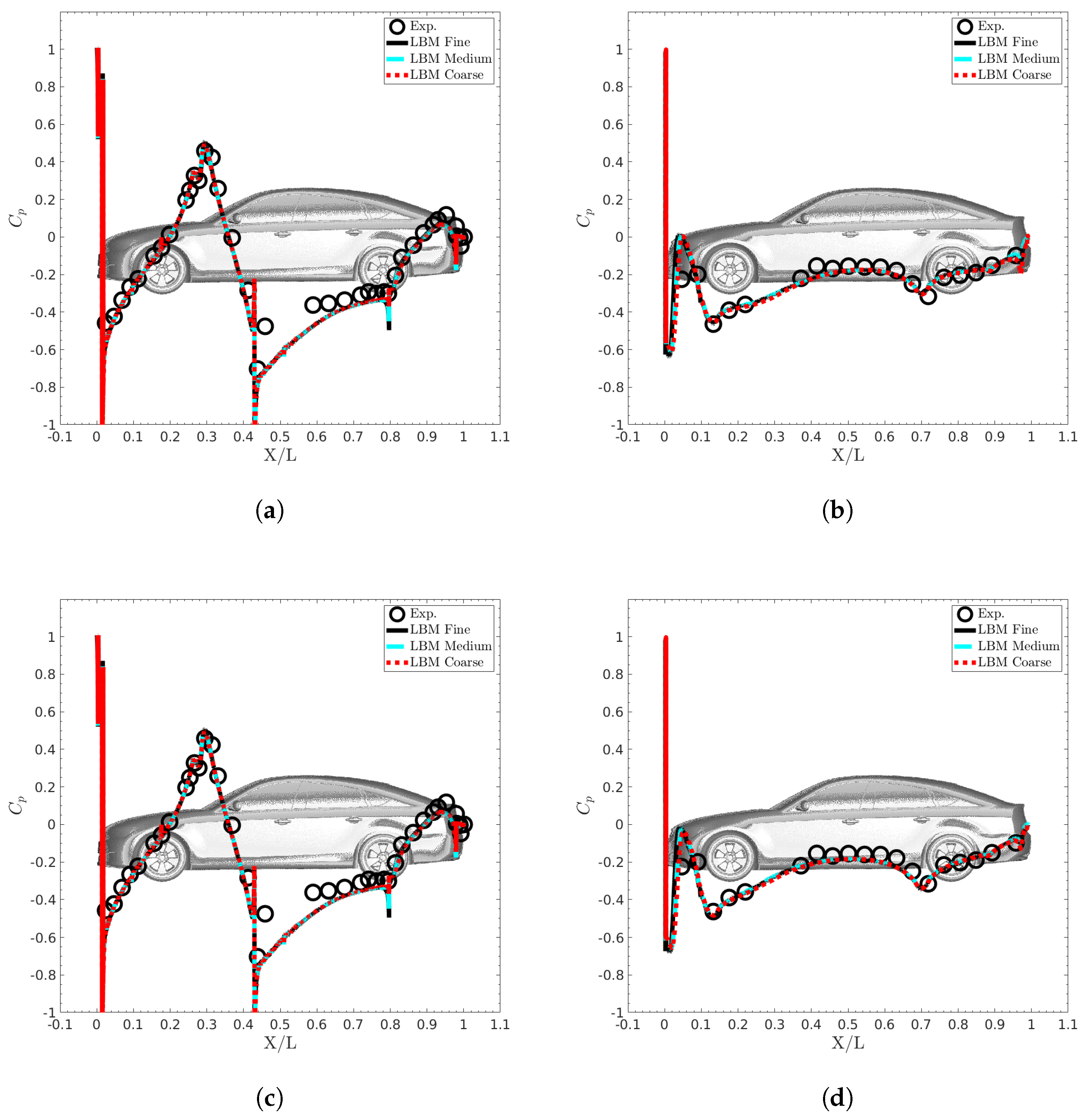
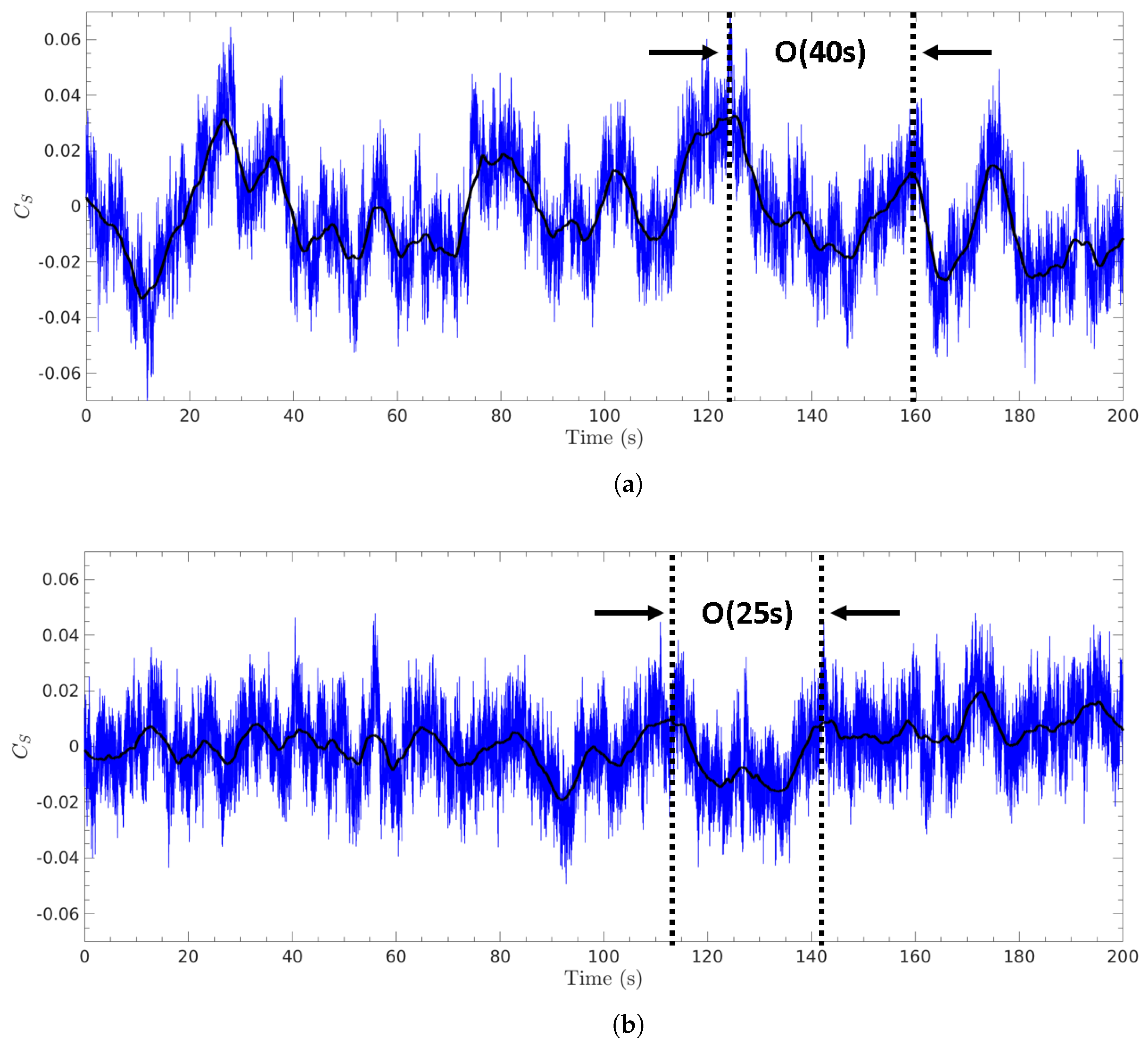
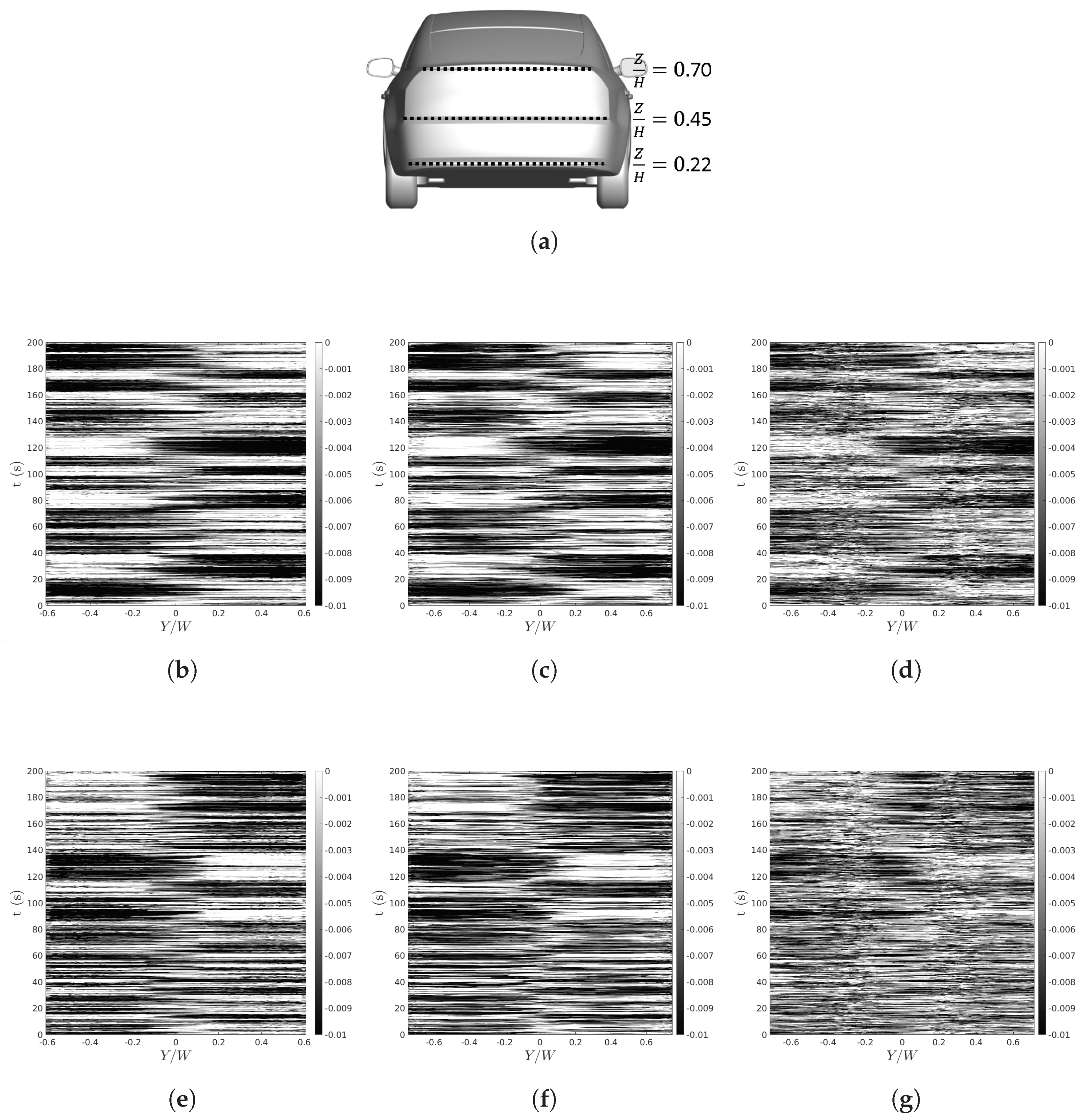
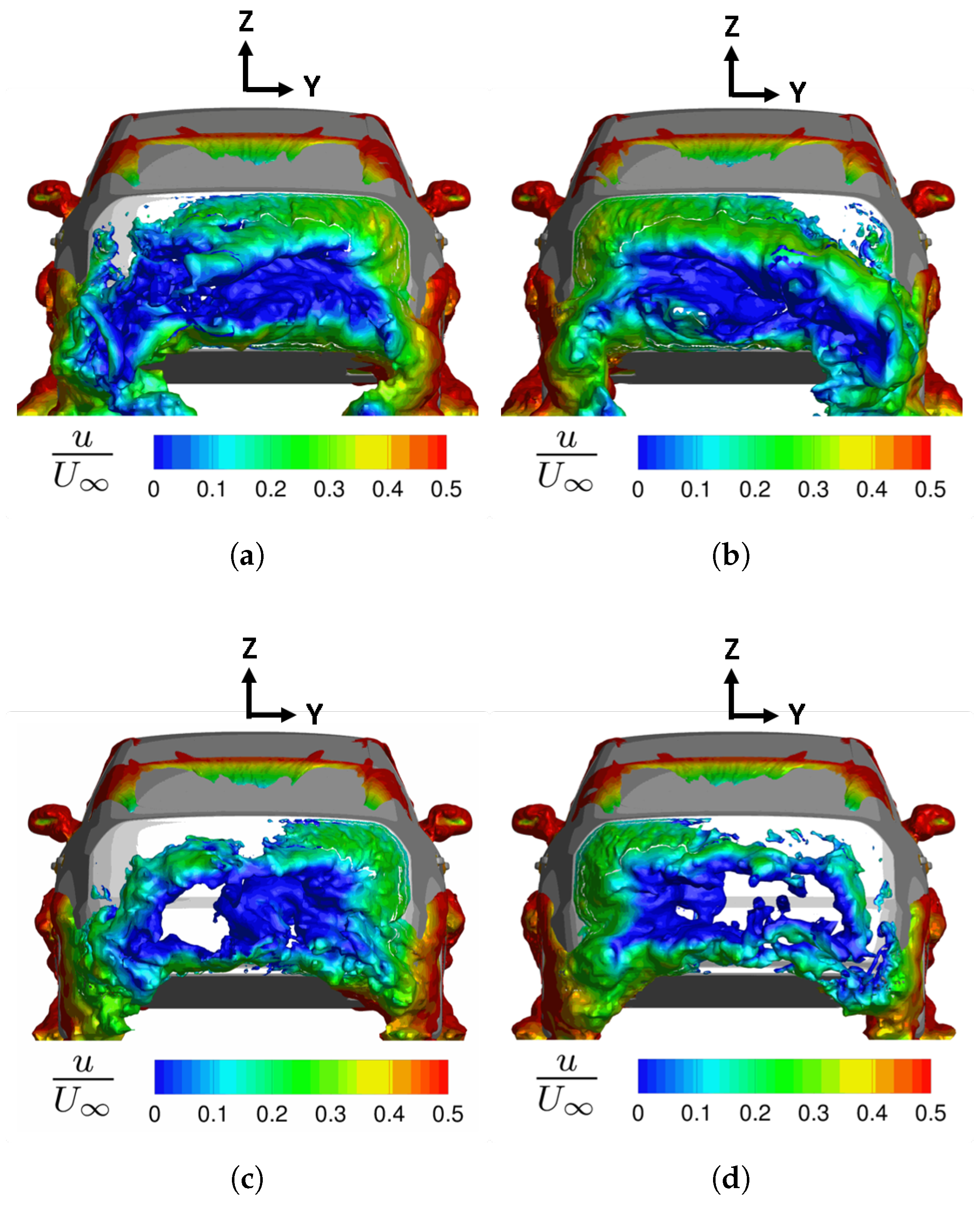
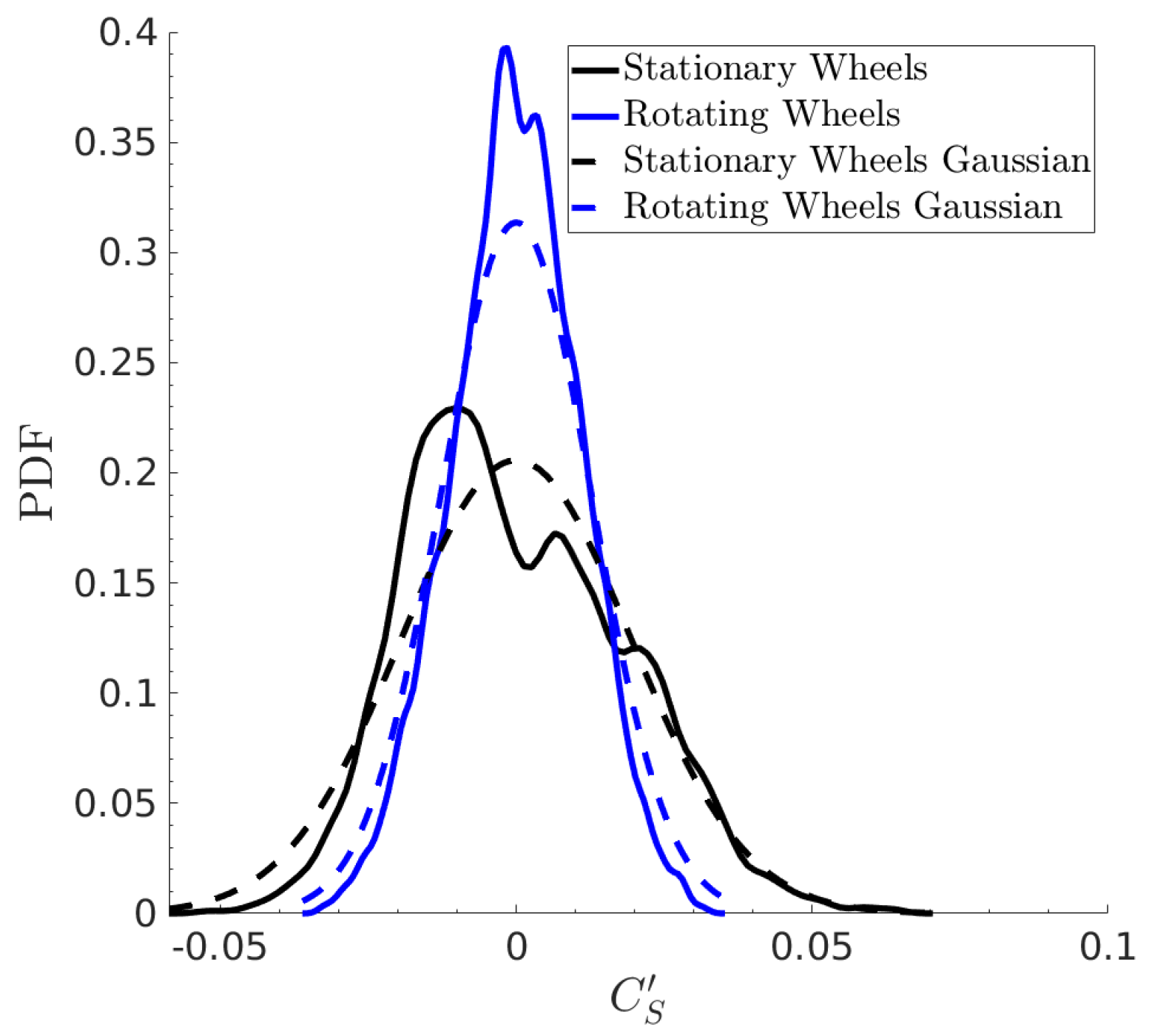
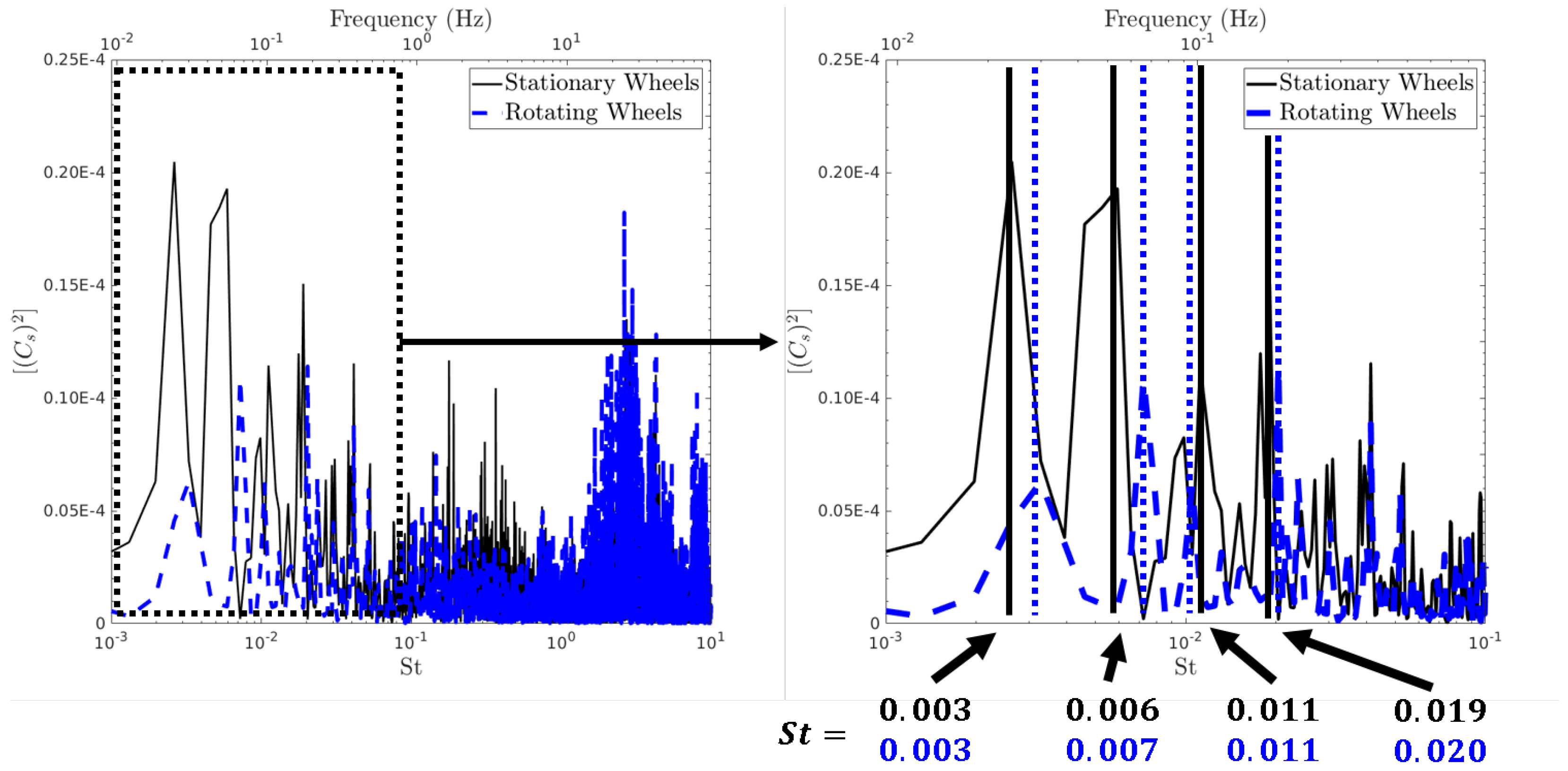
| Parameter | Coarse | Medium | Fine |
|---|---|---|---|
| Largest Voxel (mm) | 2048 | 1536 | 1280 |
| Smallest Voxel (mm) | 2 | 1.5 | 1.25 |
| Minimum Wake Refinement Voxel (mm) | 4 | 3 | 2.5 |
| Total Voxels () | 89 | 174 | 272 |
| Wall | 0.84–215 | 0.71–111 | 0.54–107 |
| Turbulence Model | RNG | ||
| Time-Step Size (s) | |||
| Method | Wheel Condition | ||||
|---|---|---|---|---|---|
| Experiments [31] | Stationary | 0.254 | – | – | – |
| Experiments [40] | Stationary | 0.254 | – | 0.010 | – |
| DES [40] | Stationary | 0.257 | – | 0.114 | – |
| LBM (Coarse) | Stationary | 0.250 | 0.054 | −0.004 | 0.016 |
| LBM (Medium) | Stationary | 0.254 | 0.059 | 0.011 | 0.011 |
| LBM (Fine) | Stationary | 0.254 | 0.060 | 0.008 | 0.010 |
| Experiments [32] | Rotating | 0.252 | 0.063 | −0.008 | – |
| Experiments [40] | Rotating | 0.243 | – | −0.060 | – |
| DES [40] | Rotating | 0.225 | – | −0.060 | – |
| LBM (Coarse) | Rotating | 0.233 | 0.053 | −0.030 | 0.003 |
| LBM (Medium) | Rotating | 0.234 | 0.051 | −0.012 | −0.001 |
| LBM (Fine) | Rotating | 0.233 | 0.052 | −0.018 | −0.004 |
Publisher’s Note: MDPI stays neutral with regard to jurisdictional claims in published maps and institutional affiliations. |
© 2021 by the authors. Licensee MDPI, Basel, Switzerland. This article is an open access article distributed under the terms and conditions of the Creative Commons Attribution (CC BY) license (https://creativecommons.org/licenses/by/4.0/).
Share and Cite
Aultman, M.; Auza-Gutierrez, R.; Disotell, K.; Duan, L. Effects of Wheel Rotation on Long-Period Wake Dynamics of the DrivAer Fastback Model. Fluids 2022, 7, 19. https://doi.org/10.3390/fluids7010019
Aultman M, Auza-Gutierrez R, Disotell K, Duan L. Effects of Wheel Rotation on Long-Period Wake Dynamics of the DrivAer Fastback Model. Fluids. 2022; 7(1):19. https://doi.org/10.3390/fluids7010019
Chicago/Turabian StyleAultman, Matthew, Rodrigo Auza-Gutierrez, Kevin Disotell, and Lian Duan. 2022. "Effects of Wheel Rotation on Long-Period Wake Dynamics of the DrivAer Fastback Model" Fluids 7, no. 1: 19. https://doi.org/10.3390/fluids7010019
APA StyleAultman, M., Auza-Gutierrez, R., Disotell, K., & Duan, L. (2022). Effects of Wheel Rotation on Long-Period Wake Dynamics of the DrivAer Fastback Model. Fluids, 7(1), 19. https://doi.org/10.3390/fluids7010019






